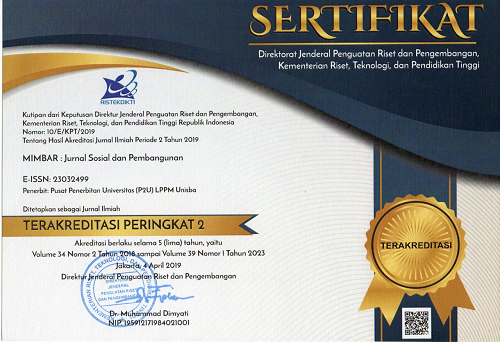Design of Bag Product’s Marketing Strategy by Implementing QFD Method and SWOT Analysis
Abstract
Production of children's backpacks has experienced a decline in sales over the past three years. This is experienced by CV Semesta Agung (SA), a textile company that produces t-shirts, jeans, and children's backpacks. The decline of children's backpacks sales occurred because of the large number of competitors and it needs a solution to overcome it. This research aims to design the marketing strategy by implementing QFD method and SWOT analysis. The method used is Quality Function Deployment (QFD) stage one, which is a matrix creation of House of Quality (HOQ) and SWOT. Based on the findings of the research, there are several product attributes that should be considered in a production of children’s backpack, such as attractive design/motif, the quality of materials and stitches, affordable price, and product durability. In addition, based on this research, it can be concluded that several marketing strategies can be implemented by companies, which is gained from SWOT method. The first one is WO strategy that can be done by expanding a marketing area in Bandung city, improving packaging design, providing product warranty, giving discount, and manufacturing waterproof children’s backpack. The second one is ST strategy by improving quality of product and worker skills, as well as reducing production cost. The third one is WT strategy by designing more attractive bag products and creating a new product.
Keywords
Full Text:
PDFReferences
Andronikidis, A., A. C. Georgiou, K. Gotzamani, and K. Kamvysi. 2009. “The Application of Quality Function Deployment in Service Quality Management.” The TQM Journal 21 (4): 319–333.
Blocher, E. J., Stout, D. E., & Cokins, G. (2011). Manajemen Biaya Penekanan Strategis. Jakarta: Salemba Empat.
Besterfield, D.H. et.al. 2012. Total Quality Management Revised Third Edision. South Asia : Pearson Education Push Print services.
Badan Pusat Stastistik (BPS). (2017). Jumlah Unit Industri Kecil Menengah di Kota Bandung. Badan Pusat Statistik kota Bandung.
David. 2009. Manajemen Strategis Konsep Edisi 12. Jakarta: Salemba Empat.
David, F. R. (2016). Strategic management: A competitive advantaga2ze approach, concepts and cases. Harlow : Pearson.
Dehe, B., & Bamford, D. (2017). Quality Function Deployment and operational design decisions – a healthcare infrastructure development case study. Production Planning & Control, 28(14), 1177–1192. doi:10.1080/09537287.2017.1350767.
E.P. Nurlaili, (2012)., “Penerapan QFD dan Analisis SWOT Untuk Menetapkan Strategi Peningkatan Kualitas Produk Sayuran Segar”., Jurnal Teknik Industri, Vol. 1, No. 3., halaman 12-21.
Gaspersz, Vincent. “Total Quality Management”, Edisi 1 Halaman 33. PT. Gramedia Pustaka Utama, Jakarta 2003.
Javandira, C., & Gama, A. W. S. (2018). Analisis Faktor Lingkungan Eksternal Dan Internal Usaha Sayur Organik (Studi Kasus Pada UD. Eka Setia Lestari Di Baturiti). JUIMA: JURNAL ILMU MANAJEMEN, 8(2), 37–50.
Koo, L.C. and Koo, H. (2007) ‘Holistic approach for diagnosing, prioritising, implementing and monitoring effective strategies through synergetic fusion of SWOT, Balanced Scorecard and QFD’, World Review of Entrepreneurship, Management and Sustainable Development, Vol. 3, No. 1, pp.62–78.
Murali, S., S. Pugazhendhi, and C. Muralidharan. 2016. “Integration of IPA and QFD to Assess the Service Quality and to Identify after Sales Service Strategies to Improve Customer Satisfaction–A Case Study.” Production Planning and Control 27 (5): 394–407.
Munadi., Ernawati & Salim., Zamroni (2015), Info komoditi Pakaian Jadi, Badan Pengkajian dan Pengembangan Kebijakan Perdagangan Al Mawardi Prima, Jakarta.
Prabowo, R., & Zoelangga, M. I. (2019). Pengembangan Produk Power Charger Portable dengan Menggunakan Metode Quality Function Deployment (QFD). Jurnal Rekayasa Sistem Industri, 8(1), 55–62.
Rucitra, Andan Linggar., (2020) The Implementation of Integrated Quality Function Deployment (QFD) and SWOT Analysis in the Quality Improvement Strategy of Jackfruit Chips. Jurnal Teknologi dan Manajemen Agroindustri Volume 9 Issue 1., p. 35-42.
Rangkuti, Freddy. 2013. Analisis SWOT : Teknik Membedah Kasus Bisnis. Jakarta : PT. Gramedia Pustaka Utama.
Subhan, Ali., (2017). Perumusan Strategi Fakultas Teknik Universitas Suryakancana menggunakan Model Gabungan Balanced Scorecard, Sun-Tzu, Quality Function Deployment & Analisis SWOT, Jurnal Media Teknik & Sistem Industri, Vol. 1 hal.50-59.
Ulrich, K. T., & Eppinger, S. D. (2001). Perancangan Dan Pengembangan Produk. Jakarta: Salemba Teknika.
Wanti, S., Taufiqurrahman, & Rahayu, D. D. (2014). Analisis strategi keunggulan bersaing dengan pendekatan analisis SWOT pada Spartan Gym Pekanbaru. Jurnal Online Mahasiswa Fakultas Ekonomi Universitas Riau, 1(2), 1–15.
Wijaya, H., & Sirine, H. (2016). Strategi segmenting, targeting, positioning serta strategi harga pada perusahaan Kecap Blekok di Cilacap. AJIE (Asian Journal of Innovation and Entrepreneurship), 1(3), 175–190.
DOI: https://doi.org/10.29313/mimbar.v37i1.7011
Refbacks
- There are currently no refbacks.
MIMBAR : Jurnal Sosial dan Pembangunan is licensed under Creative Commons Attribution-NonCommercial-ShareAlike 4.0 International License.















